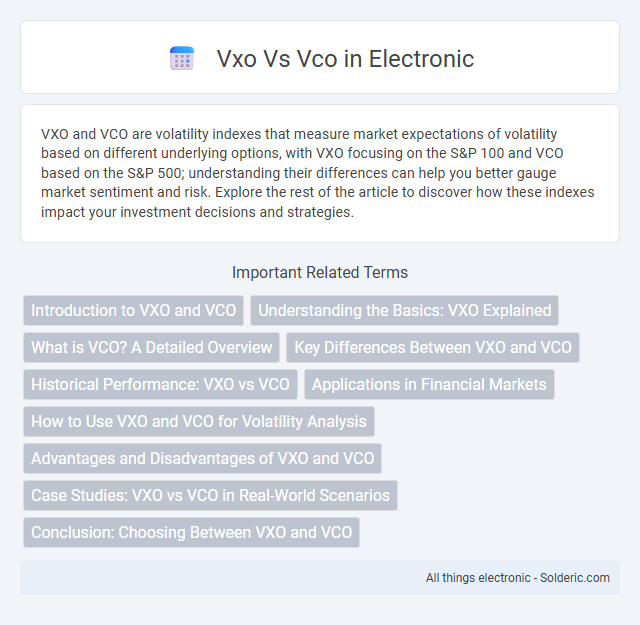VXO and VCO are volatility indexes that measure market expectations of volatility based on different underlying options, with VXO focusing on the S&P 100 and VCO based on the S&P 500; understanding their differences can help you better gauge market sentiment and risk. Explore the rest of the article to discover how these indexes impact your investment decisions and strategies.
Comparison Table
| Feature | VXO (Voltage-Controlled Crystal Oscillator) | VCO (Voltage-Controlled Oscillator) |
|---|---|---|
| Frequency Stability | High, thanks to crystal reference | Moderate to low, depends on components |
| Tuning Range | Narrow (typically a few kHz to MHz) | Wide (MHz to GHz depending on design) |
| Applications | Frequency synthesis, precise tuning | PLL synthesizers, RF modulation, signal generation |
| Phase Noise | Low phase noise | Higher phase noise compared to VXO |
| Cost | Higher due to crystal component | Generally lower, simpler components |
| Temperature Stability | Excellent, crystal-based | Less stable, affected by temperature variations |
Introduction to VXO and VCO
VXO (Volatility Index: S&P 100) and VCO (Volatility Index: Crude Oil) measure market uncertainty but target different assets--VXO tracks the expected volatility of the S&P 100 Index options, while VCO gauges anticipated price fluctuations in crude oil futures. Both indices are critical for traders and investors seeking to understand market sentiment and manage risk exposure in equities or commodities. Your strategic decisions benefit from recognizing how VXO reflects equity market volatility and VCO signals energy market uncertainties.
Understanding the Basics: VXO Explained
VXO, or the CBOE S&P 100 Volatility Index, measures expected market volatility based on options of the S&P 100, providing a gauge of investor sentiment. Unlike VCO, which tracks other volatility measures, VXO specifically reflects the implied volatility for large-cap stocks, offering insights into potential market fluctuations. Understanding VXO helps your portfolio management by anticipating market uncertainty and adjusting risk exposure accordingly.
What is VCO? A Detailed Overview
A Voltage Controlled Oscillator (VCO) is an electronic oscillator whose output frequency varies according to the input control voltage, enabling precise frequency tuning in systems like phase-locked loops and frequency synthesizers. VCOs are crucial components in communication devices, signal generators, and radar systems, providing stable and adjustable frequency sources. Understanding your VCO's characteristics, such as tuning range, phase noise, and linearity, helps optimize performance for your specific application.
Key Differences Between VXO and VCO
VXO (Volatility Index S&P 100) measures market volatility based on options of the S&P 100 index, while VCO (Volatility Index Crude Oil) tracks volatility specifically in crude oil futures markets. VXO provides insights into equity market risk and investor sentiment, whereas VCO focuses on commodity price fluctuations and energy market uncertainty. Key differences include the asset class tracked--equities for VXO and commodities for VCO--and their respective impacts on portfolio risk management strategies.
Historical Performance: VXO vs VCO
VXO and VCO represent volatility indices with distinct historical performance patterns reflecting market sentiment shifts. VXO, based on the S&P 100, traditionally exhibits higher sensitivity to large-cap tech stock fluctuations, while VCO, linked to the CBOE Crude Oil Volatility Index, tracks energy sector volatility more precisely. Your analysis of these indices should consider their unique response to economic events and sector-specific risks for accurate risk assessment.
Applications in Financial Markets
VXO and VCO are volatility indexes derived from S&P 100 and S&P 500 options, respectively, serving as crucial benchmarks for gauging market sentiment and risk levels in financial markets. Investors and traders analyze VXO and VCO values to develop strategies for portfolio hedging, options pricing, and volatility forecasting. These indexes facilitate risk management and enable market participants to anticipate periods of increased market turbulence or stability.
How to Use VXO and VCO for Volatility Analysis
VXO and VCO are volatility indices measuring market expectations derived from options prices, with VXO based on S&P 100 and VCO on S&P MidCap 400 options. You can use VXO to analyze volatility trends in large-cap stocks and VCO to assess mid-cap market risk, providing a broader perspective on market sentiment. Monitoring divergences between VXO and VCO helps identify shifts in investor confidence and potential volatility spikes across different market segments.
Advantages and Disadvantages of VXO and VCO
VXO (Voltage-Controlled Crystal Oscillator) offers superior frequency stability and lower phase noise compared to VCO (Voltage-Controlled Oscillator), making it ideal for precision applications. VCOs provide a wider tuning range and faster frequency modulation, which benefits communication systems requiring rapid frequency changes. Your choice between VXO and VCO depends on whether frequency accuracy or tuning flexibility is more critical for your specific use case.
Case Studies: VXO vs VCO in Real-World Scenarios
Case studies comparing VXO (Volatility Index Options) and VCO (Volatility Index Futures) reveal distinct advantages in liquidity, risk management, and hedging effectiveness under varying market conditions. VXO strategies often excel in options-based volatility hedging and premium capture during periods of extreme market stress, while VCO provides higher leverage and simpler execution for speculative volatility plays or directional bets. Understanding your investment goals and market context is critical to selecting between VXO's nuanced exposure and VCO's straightforward volatility tracking in real-world applications.
Conclusion: Choosing Between VXO and VCO
Choosing between VXO and VCO depends on your specific application requirements, with VXO offering superior frequency stability and lower phase noise ideal for precise, low-frequency oscillations. VCO provides greater frequency tunability and is better suited for wideband communication systems and fast frequency hopping. Your decision should balance the need for stability versus flexibility in signal generation.
vxo vs vco Infographic

 solderic.com
solderic.com